Crickets are insects in the order Orthoptera that comprise the ensiferan family Gryllidae. Some authors regard them as the superfamily Grylloidea with four families: Myrmecophilidae, Gryllotalpidae, Mogoplistidae, and Gryllidae. The group dates from the Triassic Period and today includes 3726 known living species and 43 extinct ones, 22 extant subfamilies and 7 extinct ones, 528 extant genera and 27 extinct ones. Most extant subfamilies are distributed worldwide.
DIAGNOSTIC FEATURES
The Orthoptera also include katydids, long-horned and meadow grasshoppers, short-horned grasshoppers and locusts, pigmy locusts, and wetas. Orthoptera are related to stick insects (order Phasmatodea), cockroaches (order Blattodea), and mantids (order Mantodea), all of which lack jumping hind legs. Phasmatodea have three tarsal segments, Blattodea and Mantodea five tarsal segments. Crickets are further classified in the suborder Ensifera, the members of which share jumping hind legs, two pairs of wings (rarely one) or none, either three or four tarsal segments, and thread-like antennae that are longer than the body except in subterranean forms.
Crickets all have long thread-like antennae, two slender tactual abdominal cerci, three tarsal segments, and some bulbous sensory setae basally on the insides of the cerci. No other insects share all these features; the last is closest to a single defining trait, shared by only certain Stenopelmatidae (Jerusalem crickets with four tarsal segments).
Some Ensifera have been called crickets mainly because they resemble Gryllidae, lack established common names, or otherwise have obscure family connections. All of these, however, have four tar-sal segments and are probably related more closely to one another, and to other noncrickets, than to crickets. Examples are bush crickets (a term used in Europe for certain Tettigoniidae), sand and stone crickets (Schizodactylidae), and camel crickets, cave crickets, wetas, and their relatives (Tettigoniidae, Gryllacrididae, Rhaphidophoridae, Anostostomatidae, Stenopelmatidae, and Cooloolidae). Some caelif-eran insects related to grasshoppers are called pigmy mole crickets and have two tarsal segments.
VARIATION
The smallest crickets are tiny, wingless forms comprising the subfamily Myrmecophilinae (ca. 1 mm); they apparently live and reproduce only in ant nests. The largest are the short-tailed crickets (Brachytrupinae) called bull crickets (ca. 5 cm); they excavate burrows a meter or more deep. Different cricket groups vary from having slender, fragile, whitish or greenish bodies with virtually transparent forewings (tree crickets: Oecanthinae, Fig. 1) to heavy-bodied, aggressive brown and black defenders of burrows and territories (field crickets: Gryllinae, Fig. 2, short-tailed crickets: Bachytrupinae; mole crickets: Gryllotalpinae). James Thurber said of one grylline, the sturdily built European burrowing field cricket (Gryllus campestris), that it “has the aspect of a wrecked Buick.”
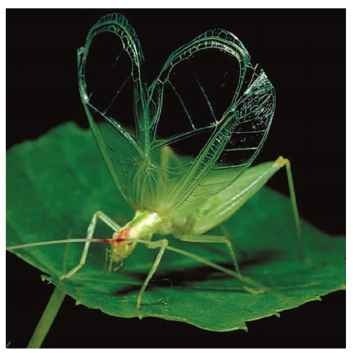
FIGURE 1 Adult male Oecanthus latipennis, with the forewings in singing position.

FIGURE 2 Adult male Gryllus pennsylvanicus.
HABITATS
Crickets live in virtually all terrestrial habitats—from treetops to a meter or more beneath the ground. Members of multiple subfamilies live in or near treetops and in bushes, grasses, and other herbaceous plants (Oecanthinae, Mogoplistinae, Eneopterinae, Podoscirtinae, Trigonidiinae) (Fig. 3); on the soil surface (Nemobiinae, Gryllinae); in caves (Phalangopsinae, Pentacentrinae); and in shallow or deep burrows (Gryllotalpinae, Brachytrupinae). Some excavate burrows in logs or standing trees (Pteroplistinae). Some beach-dwelling species of Trigonidiinae run and jump readily on water.
Females of different groups lay eggs in stems or twigs, in wood, under bark, in the ground, or in burrows. Apparently all females in the widely distributed burrowing subfamilies Brachytrupinae (short-tailed crickets, 223 species) and Gryllotalpinae (mole crickets, 76 species) are parental toward their eggs and also toward their juveniles.
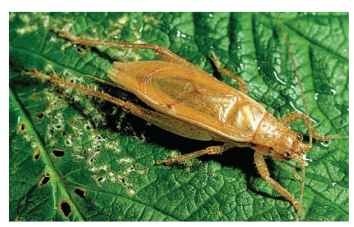
FIGURE 3 Adult male Orocharis saltator.
GEOGRAPHIC DISTRIBUTION
Crickets occur almost everywhere on the earth between the regions of taiga vegetation that start at approximately 55° North and South latitude. Excellent dispersers, they are the only orthopterans that readily colonize far-flung Pacific islands. Some colonizers fly, others tend to lay their eggs in wood, which is carried by water far and wide. Flightless soil ovipositors are poor colonizers, except via human transport. The largest numbers of cricket species audible from a single location occur in tropical regions. In Malaysia, along about 1 km of road northeast of Kuala Lumpur, the songs of 88 species can be heard, including almost every extreme of structure in cricket songs across the world. In the richest habitats of tropical Queensland (Australia), midwestern United States (southern Ohio), and some other tropical locations, up to about 25 species can be heard in single locales. Mute species, more difficult to locate, must be added to these numbers to obtain the number of cricket species in each region.
WINGS AND FLIGHT
The forewings of crickets, when present, are typically stiff and leathery; the hind wings are membranous and fold fan-like under the forewing when not being used. The hind wings can be miniature non-flying organs (microptery), longer than the forewings (macroptery), or absent. Some macropterous individuals shed their hind wings. The hind wings may also be pulled off and eaten by their bearer or by a female being courted by a macropterous male. Some macropter-ous crickets, such as the subtropical and tropical American species, Gryllus assimilis, take off, fly, and land so adeptly as to be wasp-like; others, such as mole crickets, fly in almost comically ponderous and slow manners, some with their abdomens hanging almost vertically.
SONGS AND COMMUNICATION
In most cricket species the males chirp or trill, producing clear, rhythmic, musical sounds distinctive to their family. An upturned scraper on one forewing is rubbed along a row of fewer than 10 to more than 1300 teeth, on the underside of the other forewing; tooth number, often species-specific, correlates with pulse rate and length. The dominant frequency in the sound depends upon the tooth-strike rate, ca. 1.5 – 10 kHz ( Figs. 4 and 5 ). Sounds are pulses caused by the individual closing strokes of the wings and separated by the silent opening strokes. Pulse rates vary from one every 3 s (a Hawaiian trigonidiine) to more
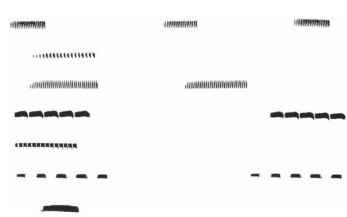
FIGURE 4 Drawings from audiospectrographs of the songs of 7 of the 17 known species of Western Australian desert crickets in the genus Eurygryllodes. Top to bottom the species are warrilla (a), warrilla (b), warrami, wirangis, yoothapina, buntinus, and diminutus. E. warrilla (a) and (b) have not yet been treated as different species because too little is known about them, and the available specimens have not been distinguished morphologically.
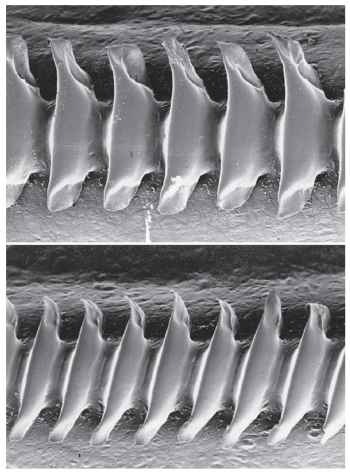
FIGURE 5 Teeth on the stridulatory files of field crickets (genus Gryllus) from the Galapagos Islands.
than 200 per second (a Malaysian gryllotalpine). The communicative significance of the songs lies in the rate and patterning of the pulses; pitch is important because the tympana on the forelegs are for each species tuned to the sounds of conspecific individuals. The calling song, best known, attracts females and challenges nearby males. The courtship or mating song induces the female to move into the copulatory position, and the fighting chirps (most obvious in surface-dwelling and subterranean species) challenge other males at close range.
Cricket sounds vary with temperature. The North American snowy tree cricket (Oecanthus fultoni), sometimes called the thermometer cricket, chirps at a steady countable rate, such that degrees Fahrenheit is represented by the number of chirps in 15 s plus 40. Individuals of this nocturnal species also synchronize their chirps, so that a dense colony produces an intense, monotonous beat. Ralph Waldo Emerson said that if moonlight could be heard it would sound like this intense, beautiful cricket song.
Tree- and bush-living crickets tend to sing only at night, those in grasses and on the ground both day and night; presumably this situation has come about because of a history of trade-offs between obtaining mates and avoiding predators, mainly birds. Some crickets are also parasitized by flies that locate males by song. In Europe and Australia certain sounds of nightjars (Caprimulgidae) are so similar to the songs of mole crickets in the same locations that it seems likely (though unproved) that these insectivorous birds attract mole crickets, both sexes of which respond to songs in flight.
Crickets were among the first musicians on earth. The calling song of each species today—as with all so-called singing insects—is invariably distinct from the songs of all other species that breed in the same times and places. Species that mature and mate in different regions, or at different times in the same region, sometimes have songs so similar as to be unlikely to be distinguished by the crickets.
Cricket acoustical communication evidently evolved but once, yet has been lost many times. In Australia the stridulum (file) has been lost at least 27 times, in Africa 17 times. The auditory tympana are often retained after acoustical communication has ceased, but only in flying species, suggesting that the tympana are used to avoid bat predation (Fig. 6).
Varying shapes and locations of the auditory tympana on the fore tibiae of crickets, and variations in the structure of the stridulatory device on the forewings of males, cause the morphological devices of crickets, as well as their songs, to be important to students of phylogeny and classification. Because of their species distinctiveness, cricket songs are unusually fine tools for locating previously unknown species and for the rapid study of geographic and ecological distribution, biogeography and phylogeny, species density variations, population size, seasonal and geographic overlap of species, character displacement, and the nature of the life cycle and overwintering stage from the seasonal distribution of adults.
Biologists have analyzed cricket songs intensively for almost 70 years because they are audible, recognizable, and amenable to sophisticated acoustical, physiological, and behavioral analysis and because hybridization of different species provides insight into the genetics of song differences. As a result of the use of song to locate new species, during the past 50 years the number of known cricket species has more than doubled. With respect to genetic background, nerve and muscle physiology, and behavioral functions, the cricket acoustical system is almost certainly the most thoroughly understood of all animal communicative systems.
EGG-LAYING
Most female crickets inject their eggs into the soil or into plant stems through long, slender ovipositors. The oviposition slashes of tree
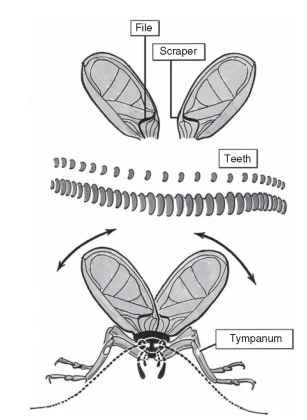
FIGURE 6 The sound-producing and auditory apparatus of a tree cricket. The stridulatory file is located on the underside of the forewing near its base. Each time the forewings close during song the teeth are rubbed against a scraper located on the underside of the other forewing. The forewings are thus caused to vibrate, more or less as a whole, as fast as the teeth are struck, producing separated pulses of a whistle-like tone. The hearing organ, or tympanum, is located on the upper portion of the front tibiae. It is tuned to the frequency of its own species’ wing vibrations, causing it to transmit the rate and pattern of pulse production of all songs at that frequency to the central nervous system. The central nervous system is able to distinguish its own species’ songs from those of other species with songs of similar frequencies that sing in the same times and places. In some crickets the tympanum is exposed through openings on both the inner and the outer faces of the tibia; in others there is only one opening, most often on the outer surface of the tibia, but in some (typically burrowing) species on the inner surface only.
crickets often seriously damage berry canes and small twigs. Females of the two subterranean subfamilies do not inject their eggs into the soil and have lost the external ovipositor; a few Brachytrupinae retain short ovipositors and inject eggs shallowfy into burrow walls. Most subterranean forms lay only a few eggs in one place in an underground chamber. In those studied, such as the North American species Anurogryllus arboreus , plant materials are also stored in the burrow, and a special defecation chamber is excavated; juveniles eat stored plant materials, small unfertilized eggs produced by the mother after the young hatch, and eventually the body of the dead mother. A female may dig her own burrow or ferociously take over and defend the burrow of a courting male before allowing him to mate with her at the entrance.
LIFE HISTORIES
In northern (and probably southern) latitudes most crickets overwinter as eggs and mature in late summer. A few burrowers overwinter as partly grown juveniles and mature in early summer. There are 6-12 nymphal molts, and the adults usually live 6-8 weeks. In latitudes with significant winters, life cycles vary from one generation every 2 years in a mole cricket to two generations each year. Diapause occurs in the overwintering stage. Nondiapausing crickets such as the house cricket (Acheta domesticus) have a generation time of a few weeks, varying with rearing temperature. Diapause also occurs during droughts in some tropical countries. Eggs or adults live through droughts, with rain causing nymphs to hatch and adults to oviposit.
FOOD
Many crickets are omnivorous. Some seem to feed almost entirely on vegetable matter, yet sometimes consume carrion and even ferociously kill and eat other insects. Several species frequent human dwellings and refuse heaps, most notably A. domesticus and the decorated cricket, Gryllodes sigillatus. Subterranean species feed mostly on roots and can be injurious when abundant in crops, gardens, lawns, golf courses, and newly reseeded forests.
HUMAN USE
House and field crickets are reared and sold in large numbers as fish bait and food for laboratory animals in many parts of the world. In the Orient, male crickets are caged for their songs, and staged battles between aggressive males in surface and subterranean species have been a favorite sport for over 1000 years. Males can be primed for serious fights—even to the death—by tickling them with brushes resembling antennae and by providing them with lairs made of small boxes that enhance their motivation to defend the site. Burrowing crickets can be extracted from their burrows by eliciting aggressive reactions to tiny pebbles rolled into the burrow followed by blades of grass used so as to imitate cricket antennae. Allowing a male to mate sets him into guarding the female for further mating, thus also priming him to fight ferociously.
MATING SYSTEM
The long-range female-attracting songs and long tactual cerci of crickets are components of a unique mating system, some aspects of which evidently trace to the earliest instances of copulation in the insect line and help explain changes leading to the current major groups of insects. Thus, none of the primitively wingless modern insects copulate, while all winged and secondarily wingless insects do, the majority with the male mounting the female and in some way holding or forcing her. In primitively wingless insects, however, a sac or bulb containing the sperm (a spermatophore) is transferred indirectly to the female without direct copulation. Like crickets, some of these particular primitively wingless insects possess prominent tactual cerci (e.g., Thysanura), used to guide the female during spermatophore transfer, as also in cockroaches and mayflies. In all insect groups of ancient origin that have prominent tactual cerci, transfer of the spermatophore is a luring act in which the female either mounts (winged and secondarily wingless forms) or stands beside the male (primitively wingless forms). In some crickets, such as the field cricket genus Gryllus ) the copulatory act appears unique among all animals in being entirely luring, with no evidence of controlling force by the male at any stage. The female is attracted initially by the long-range calling song and then by the male’s close-range courtship song and probably the fluttering touches of his antennae (Fig. 7). As in nearly all crickets, most close relatives of crickets, and most cockroaches and mayflies (the last aerially), the female mounts (or flies above) the male in the copulatory act. Apparently in correlation with the male field cricket having minimal ability to clasp the female’s genital parts, the spermatophore is transferred quickly, in 15-90 s. The spermatophore is osmotically self-emptying, so that sperm injection occurs largely after the female dismounts from the male. In forms related to crickets, such as Tettigoniidae and Caelifera, in which males have evolved terminal claspers on the abdomen, the tactual cerci have disappeared and copulation is much lengthier. In Caelifera the mating act has evolved such that the male mounts the female, though still reaching beneath her to attach the genitalia; here, unlike Tettigoniidae, the antennae have also become much shorter. Apparently luring copulatory acts in insects have repeatedly evolved into acts involving significant force, but the reverse does not seem to have happened. Groups of features related to the history of insect mating acts have significance for interpreting changes in diagnostic features of major groups of insects, including cerci, antennae, genitalia, wing structure, long-range communication, and modes of pair formation.
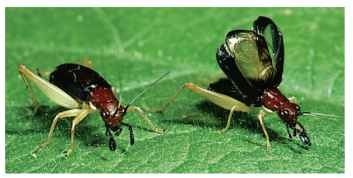
FIGURE 7 Adult female (left) and male (right) Phyllopalpus pulchellus, the latter with forewings in singing position.
Distinctive morphological and behavioral features of crickets, especially those related to their methods of pair formation and mating behavior, make them a pivotal group in understanding insect evolution and phylogeny.
